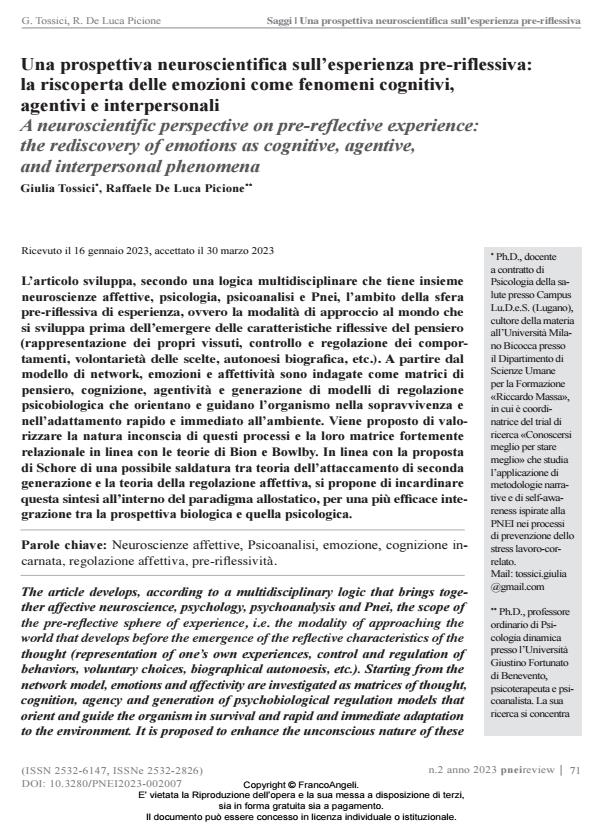Una prospettiva neuroscientifica sull’esperienza pre-riflessiva: la riscoperta delle emozioni come fenomeni cognitivi, agentivi e interpersonali
Titolo Rivista PNEI REVIEW
Autori/Curatori Giulia Tossici, Raffaele De Luca Picione
Anno di pubblicazione 2023 Fascicolo 2023/2
Lingua Italiano Numero pagine 18 P. 71-88 Dimensione file 1154 KB
DOI 10.3280/PNEI2023-002007
Il DOI è il codice a barre della proprietà intellettuale: per saperne di più
clicca qui
Qui sotto puoi vedere in anteprima la prima pagina di questo articolo.
Se questo articolo ti interessa, lo puoi acquistare (e scaricare in formato pdf) seguendo le facili indicazioni per acquistare il download credit. Acquista Download Credits per scaricare questo Articolo in formato PDF

FrancoAngeli è membro della Publishers International Linking Association, Inc (PILA)associazione indipendente e non profit per facilitare (attraverso i servizi tecnologici implementati da CrossRef.org) l’accesso degli studiosi ai contenuti digitali nelle pubblicazioni professionali e scientifiche
L’articolo sviluppa, secondo una logica multidisciplinare che tiene insieme neuroscienze affettive, psicologia, psicoanalisi e Pnei, l’ambito della sfera pre-ri?essiva di esperienza, ovvero la modalità di approccio al mondo che si sviluppa prima dell’emergere delle caratteristiche ri?essive del pensiero (rappresentazione dei propri vissuti, controllo e regolazione dei compor- tamenti, volontarietà delle scelte, autonoesi biogra?ca, etc.). A partire dal modello di network, emozioni e affettività sono indagate come matrici di pensiero, cognizione, agentività e generazione di modelli di regolazione psicobiologica che orientano e guidano l’organismo nella sopravvivenza e nell’adattamento rapido e immediato all’ambiente. Viene proposto di valo- rizzare la natura inconscia di questi processi e la loro matrice fortemente relazionale in linea con le teorie di Bion e Bowlby. In linea con la proposta di Schore di una possibile saldatura tra teoria dell’attaccamento di seconda generazione e la teoria della regolazione affettiva, si propone di incardinare questa sintesi all’interno del paradigma allostatico, per una più ef?cace integrazione tra la prospettiva biologica e quella psicologica.�
Parole chiave:Neuroscienze affettive, Psicoanalisi, emozione, cognizione incarnata, regolazione affettiva, pre-riflessività.
-
The aesthetic and affective matrix of pre-reflective sensemaking at the origins of the relationship between subject and world: A dialogue between Kant’s
Third Critique
and psychoanalysis
Giulia Tossici, Raffaele De Luca Picione, in The International Journal of Psychoanalysis /2024 pp.169
DOI: 10.1080/00207578.2024.2306937
Giulia Tossici, Raffaele De Luca Picione, Una prospettiva neuroscientifica sull’esperienza pre-riflessiva: la riscoperta delle emozioni come fenomeni cognitivi, agentivi e interpersonali in "PNEI REVIEW" 2/2023, pp 71-88, DOI: 10.3280/PNEI2023-002007